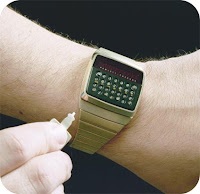New for 1946: The SmartWatch!
(Disclaimer: I work for Cisco.)
Big news! Dick Tracy has announced Microsoft’s next product. In a promotional launch event, tough, but trustworthy spokesperson Inspector Tracy demonstrated the 2-Way Wrist Phone. Welcome to 1946 everyone!
Don’t worry, you can upgrade to a 2-Way Wrist TV in 1964! You’ll just need to find Sherman and Mr. Peabody for a little ride in the WABAC machine.
Recently seen on Facebook:
If 17 technology vendors announce a new smartwatch
by the end of the month, my pet rock will quit smoking.
If 17 technology vendors announce a new smartwatch
by the end of the month, my pet rock will quit smoking.
It’s one of the latest examples of follow-the-leader among technology vendors. Or maybe it’s not even follow-the-leader, because no one is really leading a category for an amazing device
Granted, plenty of success has come from lack of need. Cue Seinfeld, a show about nothing. Enter stage right: the pet rock. And stage left: the chia pet.
And this week it seems Microsoft is jumping into the fray, wrist first. Microsoft suppliers in Asia let loose that they’ve been asked to create components that could be used to make a “smart watch.” So says Wall Street Journal, Forbes, Silicon Beat, and anyone else ready to roll his or her eyes in print. I like the headlines, really I do:
- From Forbes: Oh Dear Please Not a Microsoft Smart Watch
- From Silicon Beat: Microsoft said to be working on a touch-screen watch, which brings us to, oh, about everybody
I don’t know, but it seems like a “me too” on time delay given the last significant flurry of smartwatch rumblings was last month with LG, Google, Apple, Samsung. Then there’s Pebble, “an infinitely customizable e-paper watch” -- not that I really know what that means. And to be fair, Sony announced its SmartWatch “phone accessory” at the 2012 International CES (and Sony may have the most realistic positioning of 'em all).
But really, there have been plenty of such grand wristbanded inventions since 1946.
- 1965: A wristwatch is one of Maxwell Smart's long list of stealth telephones.

When when HP discontinued manufacturing the HP-01,
its inner workings were destroyed so no one would
copy the extraordinarily small package engineering. - 1977: Always one for highly creative product names, Hewlett-Packard releases the HP-01 wrist instrument.
- 1981: Neslonic introduces its first game watch, Space Attacker.
- 1982: David Hasselhoff had a two-way communication watch to talk to his car in Knight Rider.
- 1983: Inspector Gadget’s niece Penny has a utility wristwatch to monitor her uncle’s activities, communicate with Brain (a dog), and disrupt bad-guy plots.
- 1983: Seiko introduces the Data 2000, a watch with an external keyboard for data entry
- 2001: IBM shows a prototype for a Linux wristwatch called the WatchPad.
- 2003: Fossil releases the Fossil Wrist PDA, which runs PalmOS. By 2005, it’s a fossil.
Perhaps the human wrist is over-charted territory for watching things. Wristwatching is old school. Did Dick Tracy really have the right idea? As much as I might like watching George Clooney talk into his tuxedo sleeve in the midst of some caper, is a wristwatch the right form factor for a collaboration device? Is your wrist the best place to send information?
Flip the concept and look at wristband devices as collectors, like the Nike+ Fuelband. As the Internet of Everything evolves, it brings together people, process, data, and things to make networked connections more relevant and valuable than ever before. Sensors are a big part of that. Your phone (the smart one) already has a lot of that gathering capability. Consider the applications of a wrist device for healthcare, GPS, and other activities. (And, thank you, the ability to remove the sensor device...)
By the way, if all this talk
of watches tugs at your sense of nostalgia,
you can still buy an oh-so-classic... Casio Calculator Watch.
you can still buy an oh-so-classic... Casio Calculator Watch.


Comments
http://www.businessinsider.com/the-future-of-wearable-technology-2013-5